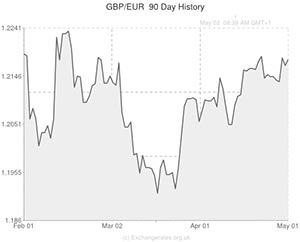
A disappointing UK construction report saw the British Pound trim its recent advance against the US Dollar and edge lower against the Euro.
On Thursday the Pound rallied against the majority of its most traded currency peers following the publication of impressive UK manufacturing data.
Sterling climbed to an over four-year high against the US Dollar and achieved a multi-month best against the Euro as the report showed that the British manufacturing sector experienced a strong start to the second quarter.
However, as the week drew to a close, a less impressive UK construction report knocked the wind out of the Pound’s sails.
The Markit construction gauge dropped from 62.5 in March to 60.8 in April, its lowest level for six months.
The decline was largely due to a tail off in the storm and flood-related work created at the beginning of the year.
However, while this result wasn’t as impressive as hoped for, the measure still holds well above the 50 mark separating growth from contraction.
Markit economist Tim Moore said this of the result; ‘Construction growth has started to moderate from the rapid pace seen over the winter, but strong rises in new work and payroll numbers provide ample optimism that output will expand strongly over the course of 2014. Better economic conditions, a surge in house building, improved access to finance and greater investment spending are all important tailwinds for UK construction growth this year.’
Meanwhile, the Euro was supported against its peers by better-than-estimated manufacturing PMI figures for France and the Eurozone.
The Eurozone’s unemployment rate also held at a positively revised 11.8 per cent in March. Economists had been expecting a jobless level of 11.9 per cent.
Before the close of trade the GBP to USD pairing may experience additional fluctuations as a result of US non-farm payrolls figures. The US economy is expected to show an employment increase of 215,000 in April, with the unemployment rate edging from 6.7 per cent to 6.6 per cent.
Next week the major UK reports to be aware of include composite and services PMI, trade balance figures and industrial/manufacturing production data.
The Bank of England’s rate decision, due on Thursday 8th, will be of considerable interest.
As the latest employment figures for the UK showed that the nation’s unemployment rate dropped to 6.9 per cent, the central bank might adopt a more hawkish rhetoric. If that proves to be the case – and as long as the BoE doesn’t attempt to talk down the currency – the Pound could gain.
Pound (GBP) Exchange Rates
[table width=”100%” colwidth=”50|50|50|50|50″ colalign=”left|left|left|left|left”]
Currency, ,Currency,Rate ,
Pound Sterling, ,US Dollar,1.6885,
,US Dollar,1.6885,
Pound Sterling, ,Euro,1.2182,
,Euro,1.2182,
Pound Sterling, ,Australian Dollar,1.8218,
,Australian Dollar,1.8218,
Pound Sterling, ,New Zealand Dollar,1.9556,
,New Zealand Dollar,1.9556,
US Dollar, ,Pound Sterling,0.5921,
,Pound Sterling,0.5921,
Euro, ,Pound Sterling,0.8209,
,Pound Sterling,0.8209,
Australian Dollar, ,Pound Sterling,0.5491,
,Pound Sterling,0.5491,
New Zealand Dollar, ,Pound Sterling,0.5113,
,Pound Sterling,0.5113,
[/table]

Comments are closed.